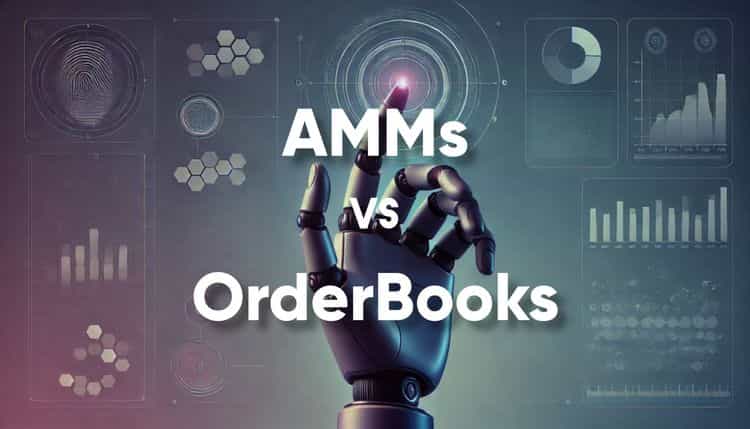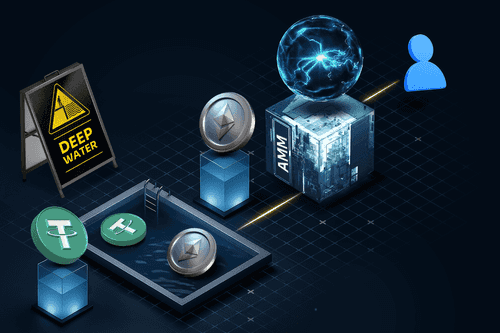AMMs vs. Order Books: How Decentralized Exchanges Are Changing the Game?


In recent years, decentralized exchanges (DEXs) have shifted from experimental interfaces to core infrastructure in decentralized finance (DeFi). As this shift has occurred, the quiet but decisive choice between automated market makers (AMMs) and order book exchanges has been placed at the center of protocol design. It may be tempting to assume that one model will simply replace the other, yet a different pattern has been observed: both are evolving, overlapping, and being combined in hybrid designs. The full article below can be read as a guide to how this amm vs order book landscape is actually playing out in practice. /
Understanding AMMs and Order Books in Decentralized Exchanges
At a high level, two distinct approaches to price formation are used in decentralized trading: automated market makers (AMMs) and order book trading systems. In AMMs, trades are routed against liquidity pools (shared token reserves governed by a pricing formula), rather than matched directly with another trader. In order book exchanges, a list of bids and asks (buy and sell offers at specific prices) is maintained, and trades are executed when compatible orders meet. In current decentralized exchanges trends, AMMs are used by most on-chain spot DEXs, while centralized exchanges and some high-performance DEXs still favor order books for precision and depth.
To understand how AMM works in practice, it is useful to consider the constant-product model popularized by Uniswap. In this design, two assets are stored in a pool, and their quantities are constrained by a simple equation, often written as x·y = k (the “constant product” rule). When one asset is bought, it is removed from the pool and the other is added, causing the price to move along the curve implied by the equation. Liquidity providers deposit both assets into the pool and receive a share of trading fees rather than placing individual orders, which changes the nature of liquidity provider strategies from active quoting to pool allocation and risk management.
How Order Book Models Work in Traditional and Decentralized Exchanges
In order book exchanges, price discovery is performed through explicit orders. A central limit order book (CLOB) records all buy and sell orders, including price, size, and time priority. The best bid and best ask at the top of the book define the spread and provide an immediate snapshot of order book depth (the amount of volume available at each price level). This structure supports sophisticated crypto trading algorithms, including market-making bots that update quotes multiple times per second and execution algorithms that slice large trades across time and price levels.
When this model is moved on-chain, several constraints are encountered. If every order and cancellation is written to the blockchain, order execution speed becomes tightly coupled to block times and network congestion. Fees are paid for each adjustment, and order book limit orders may remain unfilled for longer during periods of low crypto market liquidity. As a result, many DEXs that attempt on-chain order book trading either offload the order book to an off-chain relayer or adopt hybrid architectures, while keeping settlement and custody on-chain to preserve key decentralized exchange benefits like self-custody and censorship resistance.
Advantages and Limitations of AMMs Compared to Order Books
In live markets, the amm vs order book comparison is less about ideology and more about trade-offs among liquidity, control, and cost. It has been noted that automated market makers tend to provide standing on-chain quotes whenever adequate capital is supplied to their pools, whereas order book exchanges usually expose more granular control over execution prices but depend on continuous order updates from market-making strategies. As a result, the way liquidity is displayed and accessed is altered, and the design of DeFi trading strategies is influenced across different protocols.
From a broader decentralized finance impact standpoint, AMMs have reduced the operational threshold for becoming a liquidity provider, so participation has been extended beyond exclusively professional market makers to smaller holders as well. This wider accessibility is offset by additional risk factors, including impermanent loss (the divergence between pooled asset value and simply holding the assets), various smart contract vulnerabilities, and heightened exposure to sharp price swings.
Order book vs market maker dynamics, by contrast, tends to concentrate liquidity provision in specialized firms that can manage infrastructure, inventory, and risk at scale.

Benefits of AMMs in Providing Liquidity and Reducing Slippage
In many early-stage or long-tail tokens, amm liquidity pools have been observed to provide more reliable access to trading than thin order books. As long as a pool contains a minimum amount of value, often in the range of tens or hundreds of thousands of dollars, moderate trade sizes can be executed with predictable amm slippage as determined by the pool’s pricing curve. This behavior contrasts with illiquid order books, where a single market order can sweep through multiple price levels, producing highly irregular fills.
A typical micro-scenario can be described as follows: a small test transaction is routed through an AMM pool, a preview is shown with expected price impact and fees, and the swap is confirmed only after the quoted slippage is reviewed. When this habit is adopted, large surprises in execution price are reduced, particularly under constrained bandwidth or volatile network conditions. For retail-oriented defi trading strategies, this predictable user flow, asset selection, route preview, slippage check, confirmation, has proven more approachable than manual configuration of order book limit orders.
It has also been observed that AMMs offer composability advantages. Because pricing and settlement are controlled by smart contracts, other protocols can integrate AMMs directly, routing orders, building structured products, or executing crypto trading algorithms on top of them. These integrations increase aggregate pool usage and may improve effective liquidity even when nominal pool sizes are modest. At the same time, decentralized exchange security considerations remain: contracts must be audited, permissions carefully reviewed, and approvals minimized to the least scope required.
Challenges of order books in low-liquidity markets
Order book depth is a major advantage in blue-chip pairs with high volume, but it becomes a liability in thin markets. On low-liquidity pairs, large spreads can be observed, and the visible quotes may reflect only small sizes. For traders seeking immediate execution, crossing this spread can result in substantial slippage, even though the mechanism is different from curve-based slippage in AMMs. In addition, spoofing vectors may appear when quotes are posted and canceled rapidly, causing uncertainty about which liquidity is firm.
In decentralized contexts, extra friction is introduced. On-chain order books typically require fees for each modification, so quotes may not be updated as frequently as on centralized venues. Off-chain order book DEXs improve order execution speed but reintroduce some centralization, as the matching engine or order relay is often operated by a single entity. In either case, practical safeguards tend to include the use of small probing orders, comparison with external reference prices, and cautious use of market orders in pairs where reliable liquidity has not been observed.
How Decentralized Exchanges Leverage AMMs and Order Books
Over time, a clear pattern has emerged in DEX design: rather than a winner-take-all outcome, hybridization is favored. Some platforms, such as Injective, implement on-chain or partially off-chain order books while retaining non-custodial settlement, thereby combining centralized-exchange-like precision with DeFi-native security guarantees. Others rely primarily on AMMs but add features like on-chain limit orders, dynamic fees, and concentrated liquidity to approximate the control traditionally associated with order book trading.
In everyday use, a common procedural habit has been to route smaller or urgent trades through AMMs for certainty of execution, while larger or more price-sensitive orders are staged via order books where fine-grained control over entry levels is available. When this approach is used, the decentralized exchange benefits of self-custody and composability are preserved, while some of the precision and flexibility of centralized venues is approximated. For liquidity provider strategies, capital is sometimes split between AMM pools and order book posting, with results monitored and rebalanced as market regimes change.
The Future of Decentralized Trading with AMMs and Order Books
Looking ahead, the future of DeFi exchanges is likely to be shaped by further convergence rather than strict replacement of one model by the other. Recent decentralized exchanges trends suggest that AMM designs are being extended with oracle-based pricing, dynamic curves, and cross-chain routing, while order book systems are being reimplemented on high-performance chains or rollups where fees and latency are reduced. As these developments progress, differences in order execution speed, fee structure, and operational complexity may matter more than the label “AMM” or “order book” by itself.
For practitioners, a pragmatic stance is usually favored. AMMs may remain the default for permissionless listing, composable liquidity, and smaller trades, while order book exchanges and hybrid systems may be prioritized for derivatives, leveraged products, and large-block execution. In both cases, decentralized exchange security, transparent risk surfaces, and robust monitoring of crypto market liquidity will likely remain central design criteria.
Conclusion
When the observed evidence from current protocols is considered, no single verdict is reached in the amm vs order book discussion. Automated market makers appear to excel in providing continuous, composable liquidity and predictable behavior for moderate trade sizes, especially in long-tail assets. Order book exchanges appear to retain advantages in markets where deep liquidity, precise limit control, and complex crypto trading algorithms are required. The decentralized finance impact of both has been significant, and their coexistence now seems more stable than early narratives suggested.
Two simple heuristics can be applied in practice. First, small, reversible tests are preferred before large, irreversible actions, whether a pool-based swap or a limit order on a thin book is being attempted. Second, previews and quotes should be read carefully whenever exposure is non-trivial, with identifiers, slippage limits, and fee estimates confirmed before final submission. Under these habits, the future of DeFi exchanges is likely to be navigated with greater confidence, regardless of whether AMMs, order books, or hybrids are used beneath the interface.
Frequently asked questions
Check out most commonly asked questions, addressed based on community needs. Can't find what you are looking for?
Contact us, our friendly support helps!
What is the main difference between AMMs and order books?
AMMs use liquidity pools and algorithms to facilitate trades without requiring a direct counterparty, offering continuous liquidity. Order books match buy and sell orders from users, providing precise control over trade execution.
Why might a trader choose an order book over an AMM?
Traders seeking exact pricing and greater control over their orders may prefer order books, especially in markets with sufficient liquidity to ensure timely execution.
Are there decentralized exchanges that combine both AMMs and order books?
Yes, some platforms integrate AMM liquidity pools with order book systems to leverage the benefits of both models, offering users improved pricing and deeper liquidity.




